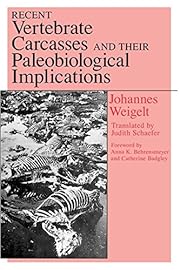The first English translation of Johannes Weigelt's 1927 classic makes available the seminal work in taphonomy, the study of how organisms die, decay, become entombed in sediments, and fossilize over time. Weigelt emphasized the importance of empirical work and made extensive observations of modern carcasses on the Texas Gulf Coast. He applied the results to evidence from the fossil record and demonstrated that an understanding of the postmortem fate of modern animals is crucial to making sound inferences about fossil vertebrate assemblages and their ecological communities. Weigelt spent sixteen months on the Gulf Coast in the mid-1920s, gathering evidence from the carcasses of cattle and other animals in the early stages of preservation. This book reports his observations. He discusses death and decomposition; classifies various modes of death (drowning, cold, dehydration, fire, mud, quicksand, oil slicks, etc.); documents and analyzes the positions of carcasses; presents detailed data on carcass assemblages at the Smither's Lake site in Texas; and, in a final chapter, makes comparisons to carcass assemblages from the geologic past. He raises questions about whether much of the fossil record is a product of unusual events and, if so, what the implications are for paleoecological studies. The English edition of Recent Vertebrate Carcasses includes a foreword and a translator's note that comment on Weigelt's life and the significance of his work. The original bibliography has been brought up to date, and, where necessary, updated scientific and place names have been added to the text in brackets. An index of names, places, and subjects is included, and Weigelt's own photographs of carcasses and drawings of skeletons illustrate the text.… (more) |


 Google Books — Loading...
Google Books — Loading...